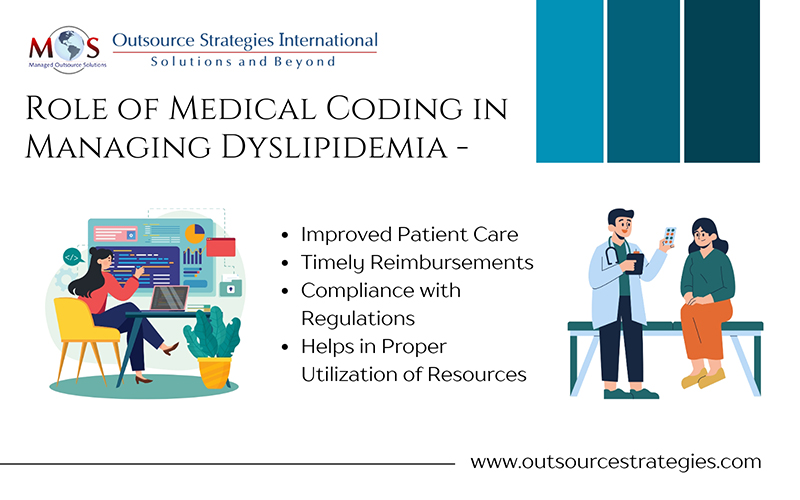A common condition prevalent due to significant lifestyle changes and dietary habits, dyslipidemia causes abnormal lipid levels in the blood. A major contributor to cardiovascular diseases, this condition involves imbalanced or high levels of cholesterol, triglycerides (or both) in the body. For healthcare providers, accurate documentation and coding of dyslipidemia using the ICD-10 and CPT systems are crucial for effective treatment planning and reimbursement processes. Documentation must provide complete details on patient history, symptoms, clinical findings, diagnostic tests, and treatment plan. Medical coding outsourcing companies and professionals must stay updated on the latest guidelines to avoid costly billing errors.
Optimize Dyslipidemia Documentation and Coding!
Take the first step towards seamless documentation and coding.
Types of Dyslipidemia and Their ICD-10 Codes
Dyslipidemia is categorized into primary and secondary types. While primary dyslipidemia is inherited, secondary dyslipidemia is an acquired condition that means it develops from other causes such as obesity, diabetes, hypothyroidism or lifestyle factors like poor diet and lack of exercise. Accurate ICD-10 coding is essential for effective billing and claim management. Here are the most commonly used ICD-10 codes for dyslipidemia:
- E78 Disorders of lipoprotein metabolism and other lipidemias
- E78.0 Pure hypercholesterolemia
- E78.00 Pure hypercholesterolemia, unspecified
- E78.01 Familial hypercholesterolemia
- E78.1 Pure hyperglyceridemia
- E78.2 Mixed hyperlipidemia
- E78.3 Hyperchylomicronemia
- E78.4 Other hyperlipidemia
- E78.41 Elevated Lipoprotein(a)
- E78.49 Other hyperlipidemia
- E78.5 Hyperlipidemia, unspecified
- E78.6 Lipoprotein deficiency
Key Documentation Requirements for Dyslipidemia
Diagnosis of this condition involves a simple blood test that checks for LDL, HDL, and triglycerides. Treatment is provided using medications like statin that help reduce LDL levels by interfering with cholesterol production in the liver. Accurate documentation is important for managing dyslipidemia effectively and ensuring proper medical coding and billing. Healthcare providers need to provide complete information about the condition to avoid misinterpretations or errors. Here are the key documentation requirements for dyslipidemia:
- Accurate Diagnosis Details: The primary documentation must include a clear diagnosis of dyslipidemia. A detailed diagnosis enables coders to choose the most appropriate ICD-10 code, avoiding denials and ensuring proper reimbursement Examples of detailed diagnoses include:
- Pure hypercholesterolemia (E78.0)
- Pure hyperglyceridemia (E78.1)
- Mixed hyperlipidemia (E78.2)
- Hyperlipidemia, unspecified (E78.5)
- Laboratory Test Results: Documentation must include the results of relevant laboratory tests to support the diagnosis such as lipid panel results and other additional tests like non-HDL cholesterol, apolipoproteins, or lipoprotein. Insurers may require the results of lab tests to justify the medical necessity of treatments, medications or other follow-up procedures.
- Underlying Conditions and Comorbidities: Document medical conditions such as diabetes mellitus, hypertension, obesity and other cardiovascular diseases. This provides a complete clinical picture, which can influence treatment plans and justify the need of additional procedures or therapies.
- Risk Factors: Patient-specific risk factors such as family history of hyperlipidemia or premature cardiovascular diseases, lifestyle factors (such as smoking, alcohol consumption, diet, and physical inactivity) and usage of medications that may affect lipid levels.
- Treatment Plan: Document lifestyle modifications (like dietary changes, exercise, and weight management), pharmacological interventions and regular monitoring and follow-ups.
- Symptoms or Lack Thereof: Although dyslipidemia is often asymptomatic, any symptoms related to associated conditions, such as chest pain or signs of cardiovascular disease, should be documented. Symptoms may justify additional diagnostic tests and provide a rationale for insurance claims.
- Social Determinants of Health (SDOH): Documenting social and economic factors such as access to healthy food, and financial limitations affecting medication adherence help impact the patient’s ability to manage dyslipidemia.
- Physician Notes: Clear, concise, and detailed physician notes like the summary of the patient’s condition, rationale for any changes in the treatment plan, and physician instructions to the patient about medication adherence serve as a reference for future visits and help in audits or claims review processes.
- Follow-up Care Instructions: Proper follow-up care documentation ensures continuity of care and supports chronic disease management. Common follow-up care instructions include timeline for follow-up visits and tests or procedures required at the next visit.
- Coding-specific Documentation: Incomplete documentation can lead to coding errors, claim denials, or underpayment. To ensure accurate ICD-10 coding, the documentation must:
- Specify the exact type of dyslipidemia.
- Provide evidence supporting the diagnosis (like lab results).
- Mention any underlying or associated conditions.

Choosing the Right Medical Coding Company
Collaborating with a medical coding company allows healthcare providers to enhance their operational efficiency, accuracy, improve compliance and focus on delivering quality patient care. When outsourcing medical coding, healthcare providers should partner with a company that has proven experience in medical billing for dyslipidemia and other complex conditions. Such companies provide the services of certified coders who ensure HIPAA compliance and data protection while maintaining privacy standards.
Ensure Accurate Medical Coding Today!
Improve your billing accuracy and streamline reimbursement processes.




